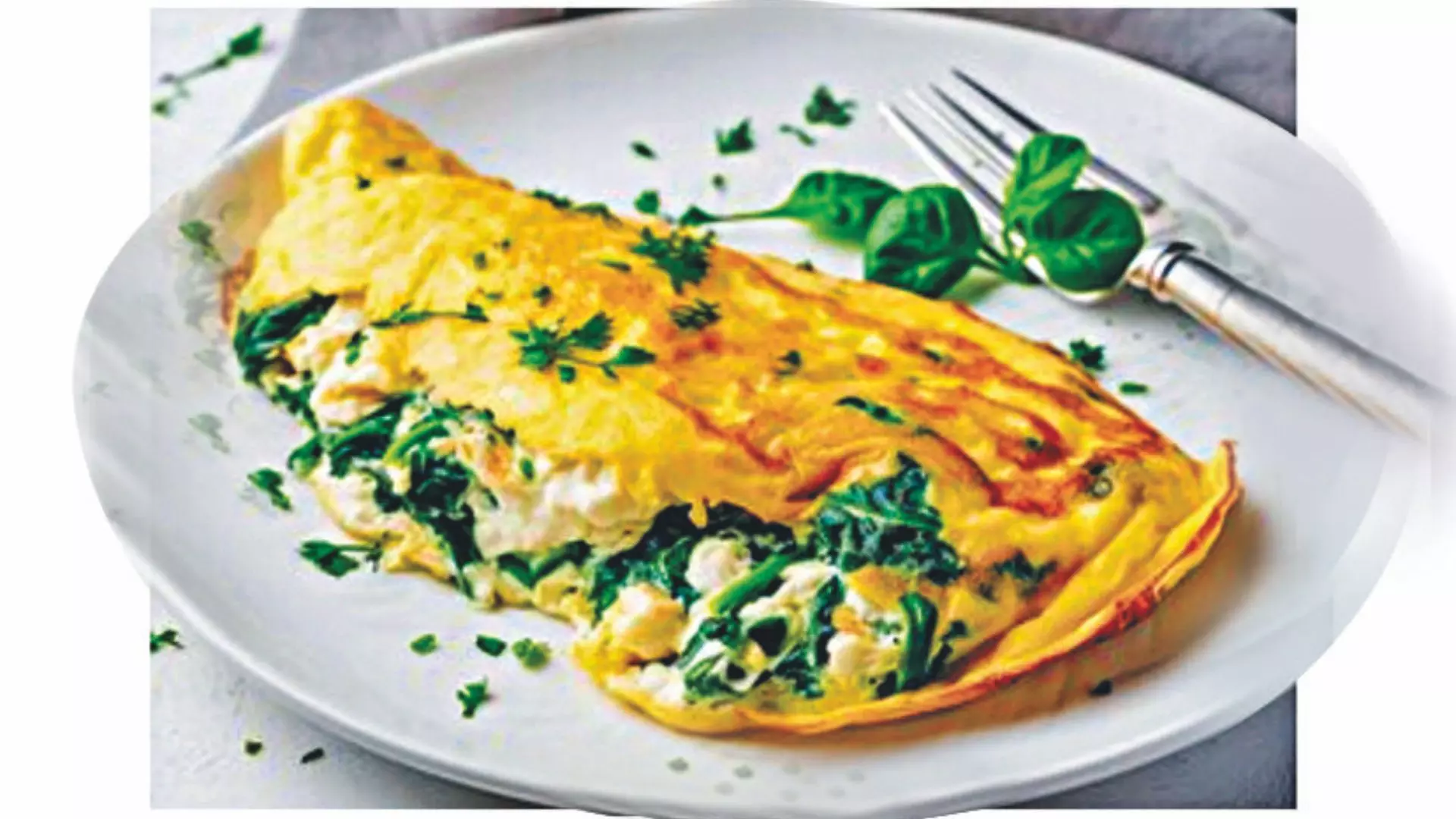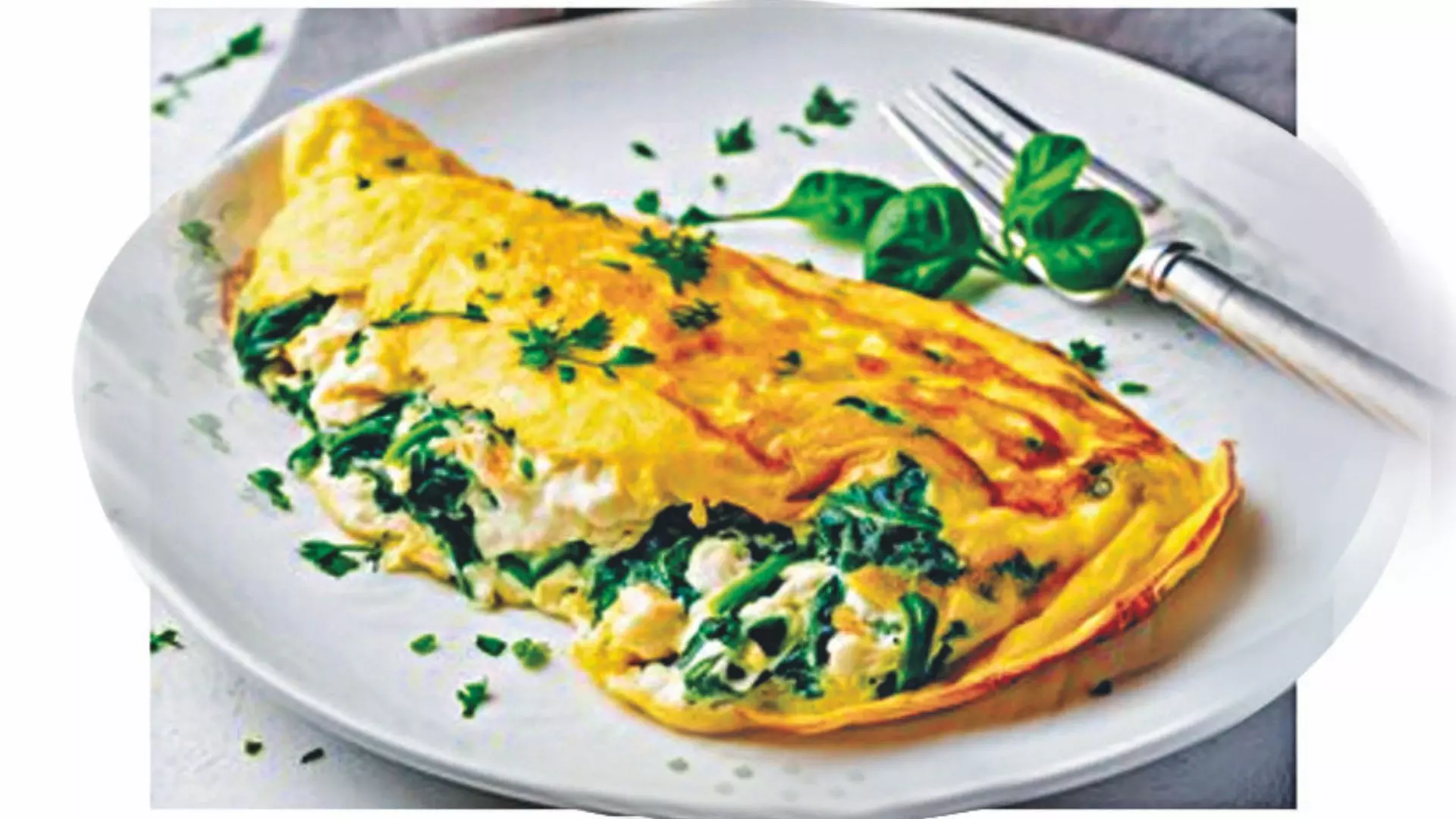
From the Spanish Tortilla de patatas (potato omelette) to the Japanese Tamagoyaki, from the Italian Frittata to the Thai Khai Chiao, the art of omelette making has advanced far beyond frying beaten eggs with pepper and salt.
The country of origin of the omelette (omelet) may be disputed, with some attributing it to Persia while others giving credit to the Romans and the French for its invention. However, there’s no dispute about the popularity of this egg dish, which can be prepared in several innovative and interesting ways.
While a double-egg omelette contains about 12 grams of protein, fats and micro-nutrients, its nutritious value and taste can be further enriched by adding a variety of vegetables, mushrooms, milk, cheese, filling it with minced meat, rice, noodles, oatmeal, soya granules and other foods. The additions can transform the plain omelette into a power-packed wholesome meal consisting of proteins, vitamins, minerals and carbohydrates.
Egg-Cellent Gyaan
Though omelette is an interesting dish and can be eaten by anyone and anytime as a snack or as a side dish or even as a full meal (depending on the ingredients used), there exists a controversy about the benefits of eating omelettes made from whole eggs or only egg whites. The daily intake of eggs can vary depending on factors such as age, kind of physical activities, BMI and presence of lifestyle diseases.
Dr K Seshi Kiran, Senior General Physician, Yashoda Hospital, Hyderabad, says, “A healthy adult, preferably within the age of 40, can eat one or two whole-egg omelette. Despite being a source of Vitamin D, A and protein, egg yolks also contain saturated fats and therefore it’s advisable that people in their 40s and 50s or above, limit its consumption to one or two yolks a week. Egg yolks are not recommended for people suffering from cardiovascular diseases, diabetes, hypertension, obesity etc.”
On the other hand, those who are into strenuous physical activities such as playing outdoor sports or gymming and weight training, can consume omelettes made of 5-6 egg whites including one or two whole eggs to make up for the muscle lost during rigorous physical exercise, point out experts.
Pack A Punch
Suhasini Mudraganam, functional nutritionist and senior consultant at Starlite Nutrition Centre, Hyderabad, shares innovative recipes to make the omelette more nutritious and delicious, catering to different age groups. The nutritionist suggests using one tablespoon (around 15 gms) of any locally available cold pressed oil such as vegetable oil, coconut oil, mustard oil and even olive oil, while avoiding too much fat like cheese and butter for frying the eggs. However, grated cheese can be sprinkled for better taste. Also remember, the more veggies are added, the better the availability of vitamins and fibre, which will aid in digestion.
Mix-Veg Oats Omelette
This one is full of vitamins and fibre besides the goodness of protein from the eggs. Saute´ several thinly sliced colourful vegetables such as yellow and red bell peppers, green capsicum, tomato, onion, carrot, beetroot, green chillies, zucchini and also mushrooms (optional). Pour a couple of beaten eggs over the sautéed veggies, sprinkle a little salt and black pepper and cook for 3-4
minutes over low flame. Add some whole oatmeal grains or powdered oats to the beaten eggs to make the dish more wholesome. The veg omelette is ready.
Spinach Frittata
Saute´ thinly chopped fresh spinach, onion and green chillies in a frying pan. Pour the beaten eggs into the spinach mix. Add salt, pepper and spices like chili flakes and grated cheese (optional) for taste. This omelette is high in protein, iron and fibre. The recipe can also be used in baked form instead of frying the eggs.
Stuffed Thin Crepes
To make one crepe, beat an egg, add a couple of tablespoons of oatmeal powder and flaxseed powder, milk, water, and a teaspoon of melted butter, season it with salt and pepper, make a smooth blend by whisking the mixture and let it stand for an hour or so. The thin batter can be poured in a non-stick pan and cooked on medium heat using a little oil or butter for frying. For fillings, vegetables, mushrooms, and spinach with a little cheese can be used.
French Toast
There are many international versions for making French toast, with most people opting for sweetened ones though it can be made savoury too. For children, who are fussy about eating, French toast will hit the right palate point. The bread slices are dipped in a mixture made of eggs, milk, cinnamon, vanilla, some flavouring substances and then toasted in butter.
Egg Pancake Variations
This recipe uses one whole egg, mixed with a tablespoon of whole wheat flour, little milk, vanilla extract or essence and a bit of baking powder, baking soda and a pinch of sugar and salt. When the mixture is even and consistent, it’s cooked on medium flame on a non-stick frying pan, using little butter. Once the pancake is ready, it can be topped with seasonal fruits. Drizzling the dish with maple syrup or date syrup or honey is optional.
Another variation of pancake requires two tablespoons of whole wheat flour and two tablespoons of protein powder and mixing these in the beaten egg, along with sea salt, vanilla extract, baking powder, baking soda, little cheese and butter. For athletes and fitness freaks, this recipe will offer a high-protein option.
